Berry Hill Bioresources Centre (2025)
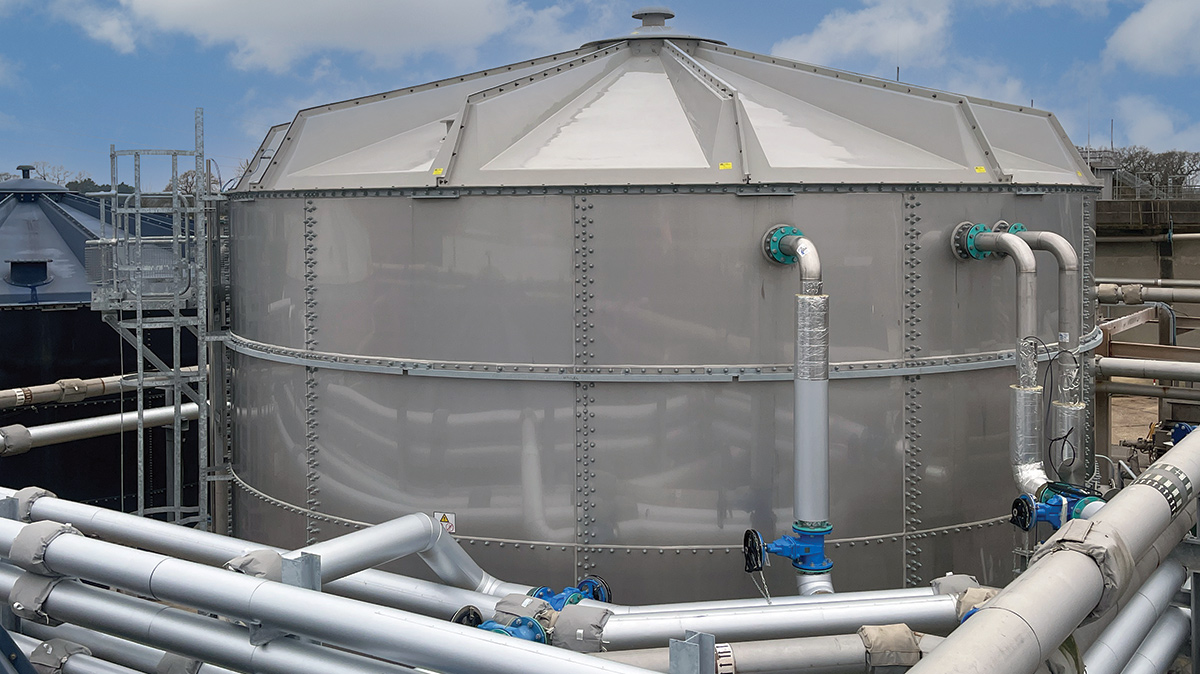
Sludge thickening tank - Courtesy of Galliford Try
The Berry Hill Bioresources Centre, situated in the north-eastern outskirts of Bournemouth, Dorset, near the areas of Throop and Muscliffe, plays a pivotal role in holding sludge from various Wessex Water satellite sites, as well as Holdenhurst Water Recycling Centre. Both raw (primary) sludge and surplus activated sludge (SAS) are transferred to Berry Hill via existing infrastructure. Recent process upgrades at Holdenhurst have led to an increased production of SAS; driven by capacity expansion and technological advancements. This increase necessitates the expansion of storage capacity by 883m3 at Berry Hill to maintain operational efficiency and compliance with environmental regulations; including those stipulated by the Environment Agency in the Water Industry National Environmental Program (WINEP) during AMP7 and beyond. Both Berry Hill and Holdenhurst serve the town of Bournemouth and the improvements at both sites will benefit a local population of approximately 176,000 (as of 2020).
Project scope & objectives
The Berry Hill Additional Sludge Storage Project aims to significantly expand the site’s sludge storage capacity for both raw and activated sludge, while ensuring seamless integration with the existing infrastructure. The key components of the project are as follows:
Foundation works: Construction of a robust foundation utilising 36 concrete-filled augured piles, each with a diameter of 600mm. These piles are designed to support the new tank slab, the tank itself, and its full contents, ensuring structural stability and long-term durability.
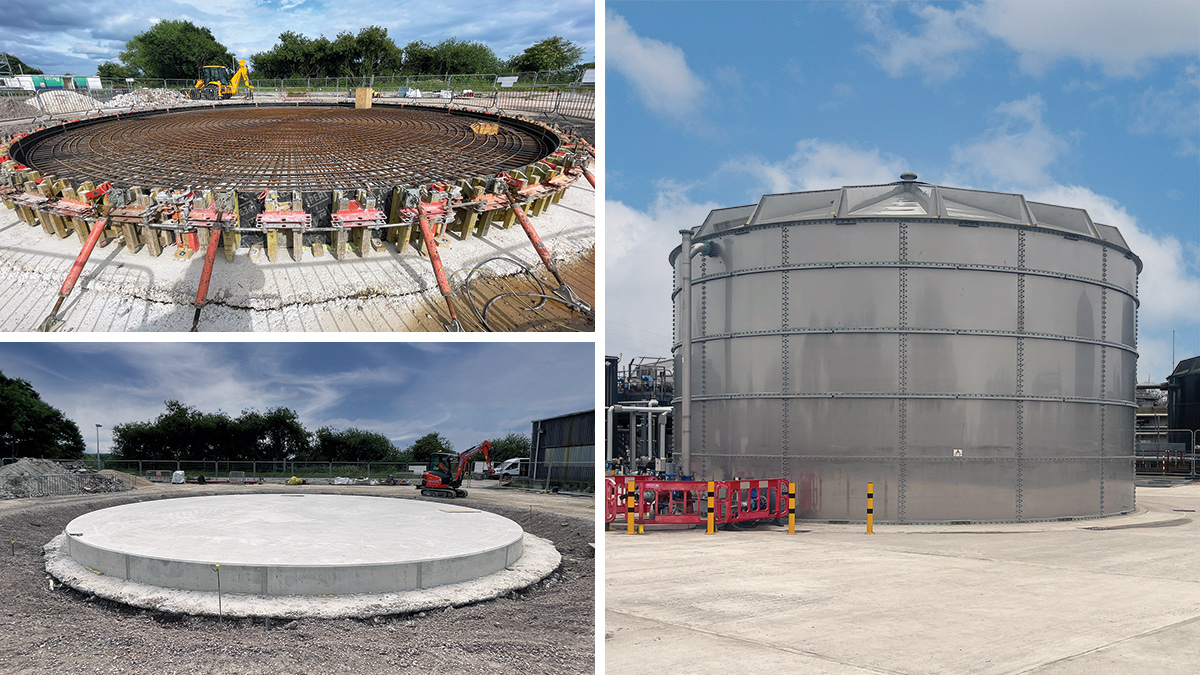
(top left) Tank base steel reinforcement in place, (bottom left) surplus activated sludge tank base slab, and (right) the new surplus activated sludge tank – Courtesy of Galliford Try
New SAS reception sludge tank: The installation of a new 6.5m-tall, 316L stainless steel SAS reception tank with a diameter of 12.8m is designed to optimise the available space at Berry Hill while providing an additional 718m3 of storage capacity. This tank includes advanced equipment for sludge agitation and transfer, ensuring that the stored sludge is kept in optimal conditions.
Modifications to existing sludge thickening tanks: The enhancement of the current assets increases sludge storage by a total of 165m3, while minimising the necessity for additional land use. Reusing and modifying the existing concrete foundations offers a viable solution that lessens the need for extensive concrete demolition and the installation of new piles and use of new materials.
Process upgrades: Six new NOV progressive cavity pumps will be installed to optimise the sludge transfer process. These pumps will improve energy efficiency and provide more precise control of the sludge flow. Each tank will also be equipped with a new Hidrostal mixer pump to maintain proper agitation and minimise sedimentation.
Additionally, all equipment will be integrated into a fully automated system using stainless-steel pipework, which will be trace-heated and jacketed to ensure optimal operating conditions through all environmental conditions. The pipework installation has been configured in such a way that all tanks can be filled with both raw sludge and SAS.
This integrated system will improve both the efficiency and reliability of the sludge handling process. The development and integration of new software by Wessex Water will ensure automation and control of the system in line with other site assets, ensuring whole site management and efficiency during the entire sludge storage and transfer process across the site, and reducing the requirement for manual operation substantially during the sludge transfer process.
With the additional 883m3 of storage capacity, the site will be better equipped to manage both current and future demands.
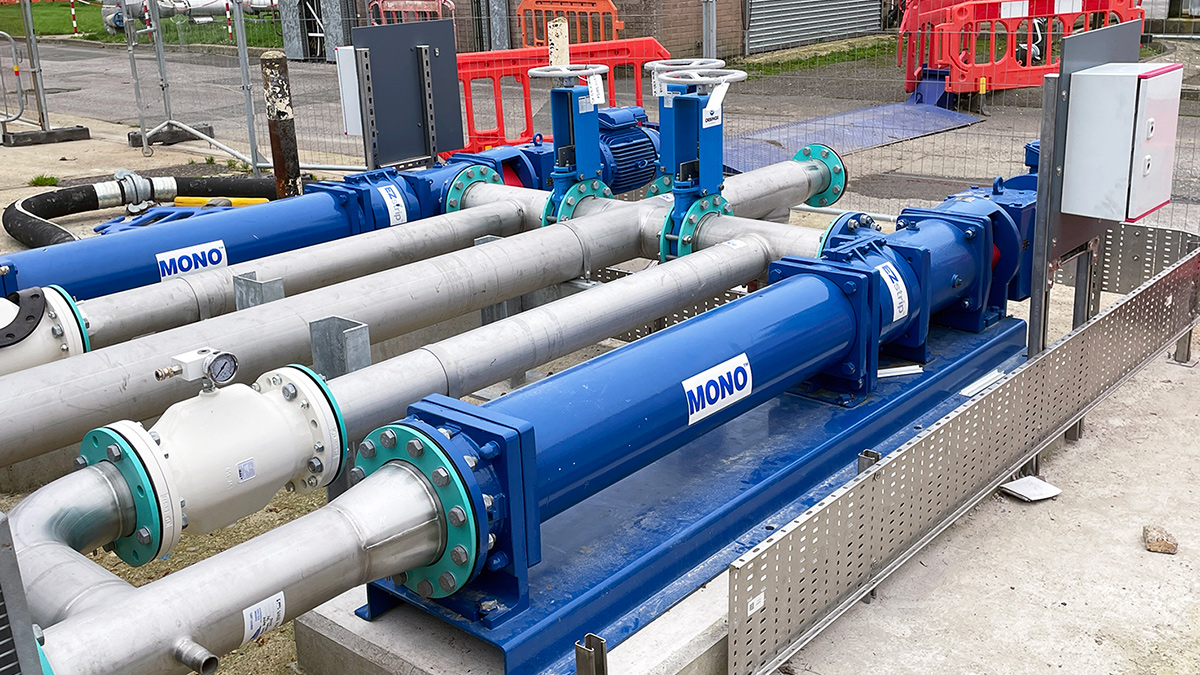
NOV progressive cavity sludge transfer pumps – Courtesy of Galliford Try
Berry Hill Bioresources Centre: Supply chain – key participants
- Client: Wessex Water
- Principal contractor: Galliford Try
- Client designer: Mott MacDonald
- Civils contractor: Bartlett Contractors Ltd
- Piling design & installation: Suttle Projects Ltd
- Electrical installation: Spectrum Electrical Group
- Stainless steel tank supplier: Hayes GFS Ltd
- Tank mixer pump supplier: Hidrostal
- Stainless steel pipe fabrications: ABC Stainless Ltd
- Access platform fabrications: Atom Fabs Ltd
- Pump supplier: NOV Pumps (Mono Pumps)
- Trace heating & lagging: Jade Insulation
Design & construction
This project is a collaborative endeavour involving multiple stakeholders: Galliford Try serving as the Principal Contractor, Wessex Water acting as both the client and Principal Designer, and Mott MacDonald as the client designer.
The implementation of 3D modelling facilitated precise design optimisation and seamless integration with existing infrastructure. By simulating the entire process layout, potential design conflicts were identified early on, resulting in reduced rework, minimised material waste, and more efficient resource utilisation. All stakeholders, contractors, subcontractors, and other relevant parties could visualise the scheme and its intentions before construction commenced, allowing for a comprehensive constructability and risk identification process to develop substantially prior to on-site activities.
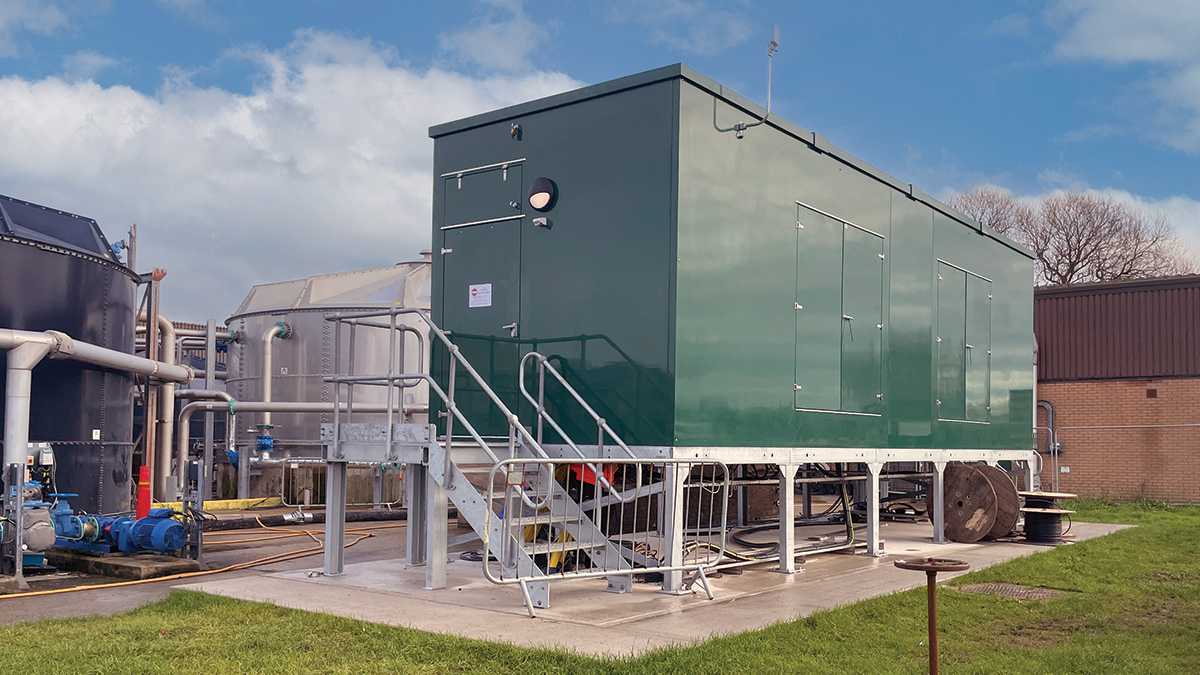
Elevated kiosk housing the sludge thickening MCC – Courtesy of Galliford Try
Key design and construction elements include:
Piling & foundation works: The foundation system incorporates augured piles, a robust solution that ensures a stable substructure for the new sludge storage tank. This piling method effectively mitigates potential settlement concerns and safeguards the long-term structural integrity of the facility. By implementing this proven technique, the project adheres to industry best practices and prioritises durability and resilience in its design.
Sludge tanks: The new tanks were engineered for durability and long-term operational efficiency, incorporating corrosion-resistant 316L stainless steel materials and a lightweight GRP roof. While the tanks increased the capital expenditure, they significantly surpass industry standards and provide superior suitability for their intended environment.
The existing sludge thickening tanks underwent capacity enhancements through hydro-demolition techniques. This method facilitated precise removal of concrete sections from the existing structures, exposing the underlying steelwork to enable structural integration for the new reinforcement.
The modified concrete structures were subsequently fitted with 316L stainless steel tank sections and a GRP roof covering. 316L stainless steel was selected over glass-fused-steel (GFS) due to its superior resistance to corrosion caused by elevated hydrogen sulphide concentrations.
Process integration: The installation of upgraded stainless-steel pipework and pumping systems significantly enhances the efficiency of sludge transfer operations. This improvement contributes to increased operational resilience by mitigating the risk of blockages and minimising maintenance requirements. The robust and corrosion-resistant properties of stainless steel ensure long-lasting performance and reliable sludge conveyance, optimising the overall system’s productivity and cost-effectiveness.
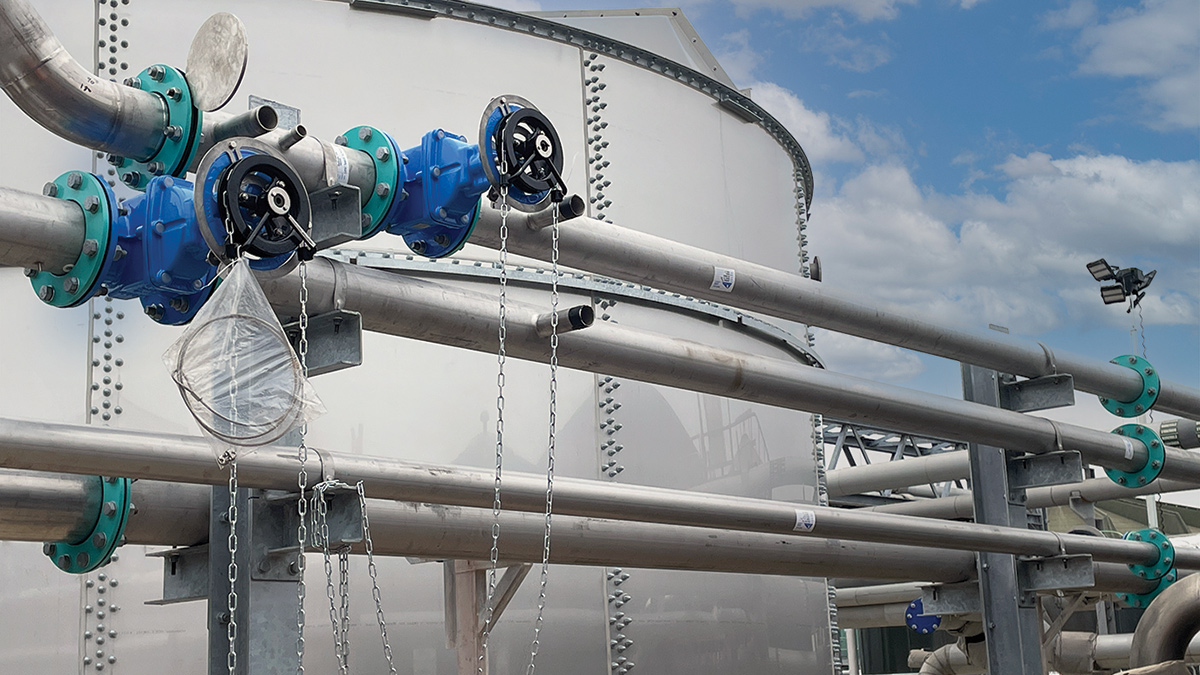
Stainless-steel pipework and valve arrangement – Courtesy of Galliford Try
Electrical & control systems: The implementation of state-of-the-art motor control centres (MCCs) and sophisticated control systems facilitates meticulous monitoring and regulation of sludge processing operations, thereby enhancing overall process optimisation.
These cutting-edge technologies empower operators with granular insights and precise control mechanisms, enabling them to streamline procedures, maximise efficiency, and ensure adherence to stringent quality standards. By harnessing the capabilities of these advanced systems, wastewater treatment facilities can achieve unparalleled levels of operational excellence, underscoring their commitment to environmental stewardship and sustainable resource management.
Innovations, cost savings & carbon reduction
The project’s innovative approach involved repurposing existing infrastructure and integrating energy-efficient pumps and control systems. This strategy is projected to yield substantial reductions in operational expenditures and carbon emissions. Additionally, the implementation of off-site building (OSB) methodologies, where feasible, contributed to minimising emissions and the overall carbon footprint. Crucial project components underwent a meticulous process of manufacturing, assembly, testing, and witness-testing before being delivered to the site as comprehensive packages.
The project incorporates several elements designed to enhance efficiency, curtail costs, and mitigate environmental impact:
- Optimised storage solutions: The project optimises storage capacity by modifying existing tanks and constructing a new one, thereby minimising the need for additional land use, material waste, and utilisation of virgin materials. This approach results in cost savings and reduced environmental impact.
- Enhanced process control: The integration of sophisticated MCCs, variable speed drives, and advanced control systems facilitates more precise sludge management processes. This enhanced level of control and automation results in reduced energy consumption and lower operational expenditures for wastewater treatment facilities. By optimising sludge handling operations through cutting-edge technological solutions, substantial cost savings can be realised while promoting environmental sustainability.
- Use of 3D modelling: The utilisation of three-dimensional modelling techniques enabled the early detection of design conflicts, thereby minimising the need for rework, reducing material waste, and mitigating associated costs. This proactive approach streamlined the design process, optimised resource allocation, and enhanced overall project efficiency.
- Carbon reduction measures: Wessex Water’s dedication to sustainability is reflected in its strategic approach to repurposing existing infrastructure, optimising process efficiency, and utilising operational support busses (OSBs). These initiatives collectively contribute to a reduced carbon footprint, underscoring the company’s commitment to environmental stewardship and responsible resource management.
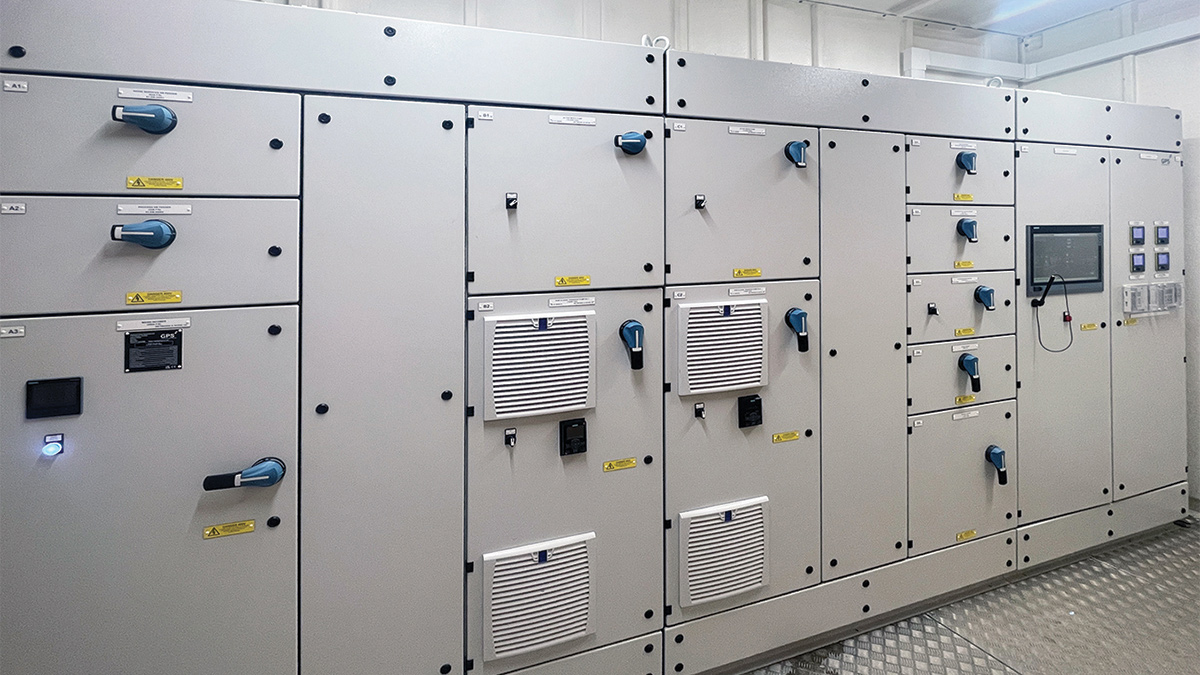
New MCC – Courtesy of Galliford Try
Conclusion
With a budget of £5m and a duration of 17-months, the Berry Hill Bioresources Centre Additional Sludge Storage Project signifies a crucial investment in Wessex Water’s wastewater management infrastructure. Practical completion was achieved in March 2025; thereby improving the efficient handling of increased sludge volumes whilst minimising environmental impact.
Through enhanced storage capacity, integration of advanced process technologies, and implementation of sustainable design principles, the project exemplifies a forward-thinking approach to wastewater treatment.
The collaborative efforts of Galliford Try, Wessex Water, and Mott MacDonald have been instrumental in delivering a solution that addresses both immediate and long-term operational requirements.
The Berry Hill Bioresources Centre Additional Sludge Storage Project stands as a testament to effective engineering, strategic planning, and sustainable wastewater management practices. The investment ensures that Wessex Water can continue meeting the evolving demands of its service area while upholding environmental stewardship.
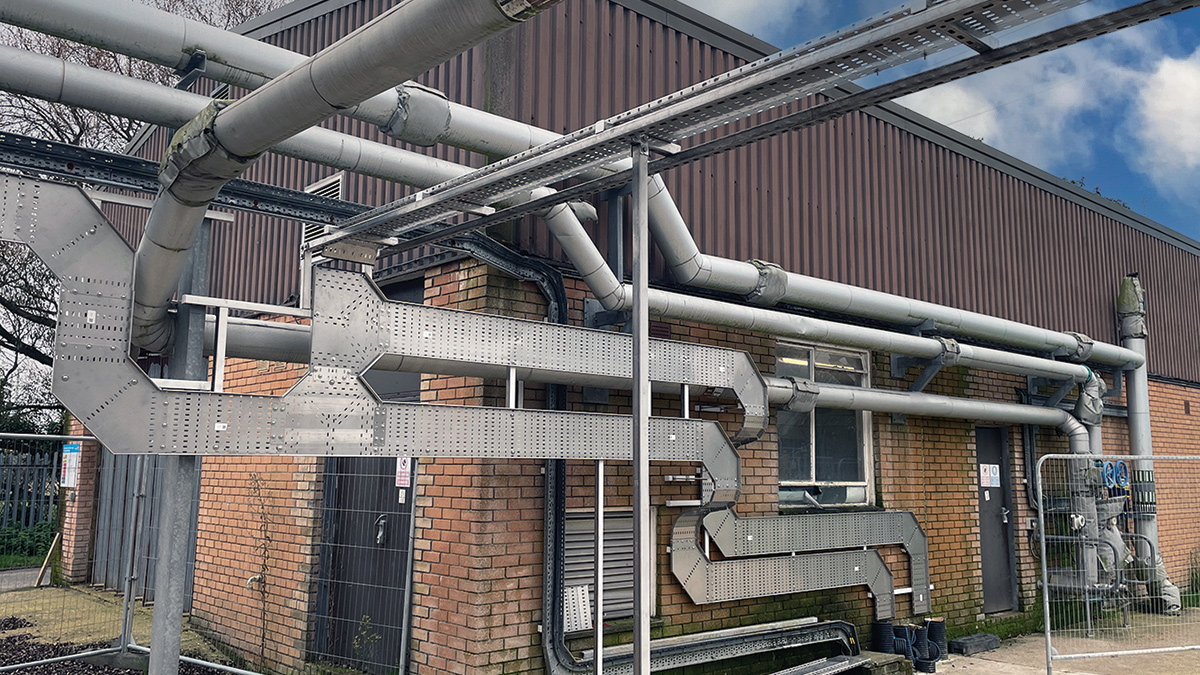
Stainless steel cable containment - Courtesy of Galliford Try







